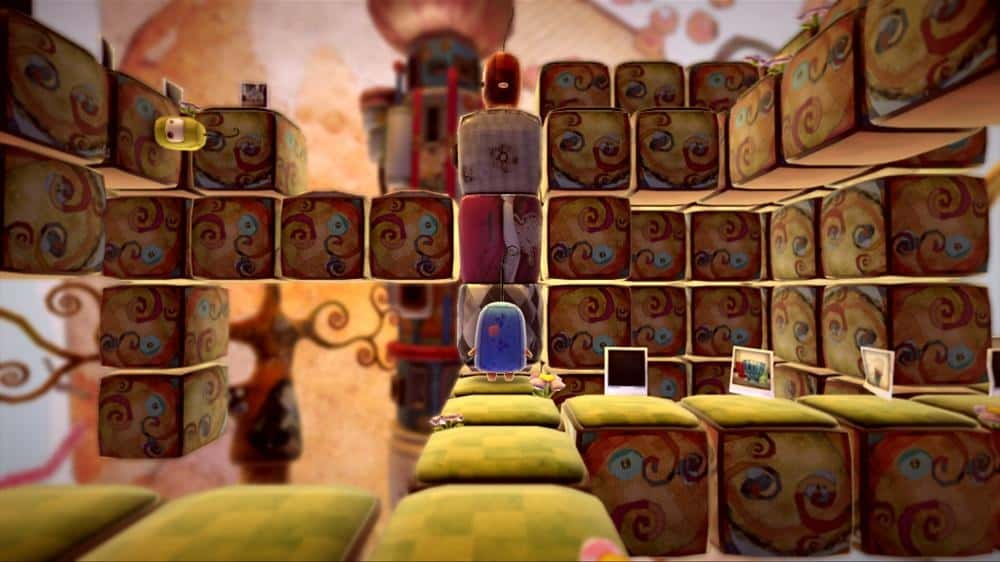You can trust VideoGamer. Our team of gaming experts spend hours testing and reviewing the latest games, to ensure you're reading the most comprehensive guide possible. Rest assured, all imagery and advice is unique and original. Check out how we test and review games here
Here’s the story of two plush aliens lost in a three-dimensional puzzle, just trying to push blocks around. If you structured it as joke you’d start with “two aliens walked into a bar” and then realise, no, actually they didn’t even do that. They walked around it and kind of underneath it and pushed something over and then met up and had some tea. And there’s the heart of it, the meaty pulp of ilomilo’s humour: it’s an absurd principle that’s been developed into a game.
The soft and simple objective is always to meet up and have a cuppa in a park, but to get there the duo are always forced to take the longest, hardest and most puzzling road. If you take the game in terms of its plotline, you play 49 levels to get to your mug, and I’m stressing this because it’s the quirky absurdities that fuel ilomilo. Its personality is what you’d get if you took Katamari Damacy and Noel Fielding and forced them to mate as part of a century-long breeding program designed to create the surreal.
Generally speaking, however, I’m wary of games that use a cute aesthetic as a primary selling point, but it’s rare for a game to take what’s ostensibly a superficial design concept and make what feels like a legitimate and living ecosystem.
Each level takes place in a floating landscape made out of cubes; some are living, some are homes, some react to you moving past them, others can be used to build walkways. In the most literal way possible the building blocks are infused with the very personality of the game. Sebastian is the character that takes you through the world, a very basic level-introducer who explains to you what to expect. He lives in a cube under the ground, flies a kind of unhappy sofa-ladybird, owns 73 hats but only wears one and openly mocks modern first-person shooters. The cubes used to build walkways have a hapless look of a puppy merged with a slinky, some just big enough to fill a small cube-shaped crevice, others stretching to fill long gaps. Other ones might house or hide various creatures that effect gameplay, from animals that block your path to the kind of worms you’d expect to spill out of some kind of hideous deep sea trench, popping out like a jack-in-the-box to steal your all-important cube.
There’s a whole world in this, and for a game that really doesn’t bother to have much of a story to tie each very different environment together, it feels like everything conforms to the game’s absurdist logic. Your role as both ilo and milo is essentially to follow that logic to its conclusion. You might call the gameplay similar to Lost Vikings to some degree, with one character helping the other by moving cubes about or collecting objects not easily available to the other. ilo and milo are forever placed on opposite sides of the level, meaning your objective is always to find a way of bringing them together. If there’s no obvious way to go further then you make a path with what you’ve picked up.
You have the ability to easily switch between the pair or play as one in co-op, but there are also secondary objectives which involve collecting items and creatures across the level. In both cases you often use all sides of the terrain – it’s all cuboids, remember, and on certain parts of the path you’re led sidelong or underneath the blocks to collect items and solve the puzzle.
And it can get impressively difficult. You might be reading this a month from now, living in a world where YouTube walkthroughs for ilomilo are clogging every artery of the Internet. Lucky you, perched in your grandoise tower of laziness, solving puzzles by looking up what xChodeking90x said to do when you get to the bit with the snakeworm. If you play this game without googling for clues it’s often frustratingly tricky in later levels. Even the design of the puzzles takes a turn toward the difficult, starting with its flat and blocky park stages and leading toward spiralling helix constructions which get you to drop below the floor and run upside-down, then back up again to your original position.
Which means it does occasionally get hard to tell where you are, and also where you have been. Unfortunately the game’s “Helper Bubble” system has been notorious for causing crashes and freezing, and as of this minute the issue can only be bypassed by turning help off entirely. It’s an issue developer Southend Interactive is working on.
But ignoring that for a minute, the game is designed for trial and error. You’ll be told by the game that “the solution will often come if you approach the puzzle from a different angle” and that ought to be taken as much literally as it should be figuratively. You need to view the puzzle from every angle to decide what your next move should be.
It doesn’t hurt to get a second pair of eyes on it, though. It’s made slightly easier with local multiplayer, which gives you the opportunity you point your playmate in the right direction. Co-op lets you play as one of the titular characters and highlight blocks to suggest the next move for the other player, making it a literal interpretation of what’s happening on screen – you’re just friends helping out friends. There’s no way to fail in ilomilo; all blocks that have been put down can always be picked up again and re-used. Instead there’s only constant and consistent encouragement to finish every level fully satisfy the completionist gamer part of your brain.
At 800 Microsoft Points ilomilo is ludicrously good value for money. A relatively short game but in between the dozens of collectibles, from vinyl records that unlock concept art and music to creatures hidden around each level that give you bonus stages, it’s an impressively in-depth and polished XBLA game.

/https://oimg.videogamer.com/images/8dfe/ilomilo_8.jpg)






